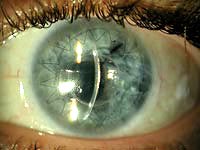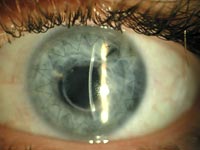‘Mushroom keratoplasty’ a promising option for corneal transplantation
The technique combines the advantages of lamellar grafts and penetrating keratoplasty, with good corneal clarity and little risk of rejection.
Click Here to Manage Email Alerts
  “Mushroom keratoplasty” was performed in the eye of a 25-year-old professional tennis player. At 2 months postop, both the large anterior lamellar graft (the head of the mushroom) and the small posterior lamellar graft (the stem) are clear. The interface is visible in the slit lamp. Images: Busin M |
A novel technique of corneal transplantation that combines the advantages of large lamellar grafts and penetrating keratoplasty can effectively treat full-thickness opacities with minimum removal of recipient endothelium, according to one surgeon.
The procedure, named “mushroom keratoplasty” by its creator, might be the best option for patients who have a normal, healthy endothelium but with central corneal scars and full-thickness opacities due to penetrating injuries, infections and degenerative disorders, according to Massimo Busin, MD.
“In these patients, the conventional procedure is penetrating keratoplasty, which effectively restores vision but frequently exposes them to the risk of immunologic rejection,” Dr. Busin said.
Keratoconus patients may also benefit from this new approach, he added.
Two-step procedure
Surgery is carried out in two steps, Dr. Busin explained. First, a 9 mm wide and 200 µm thick superficial lamella – the mushroom’s head – is removed from the recipient’s eye by hand dissection. Next, a 5-mm trephine is used to make a circular incision in the center of the stroma, and a central button of stromal and endothelial tissue — the stem of the mushroom — is excised with scissors.
In the donor’s eye, a large corneal lamella 200 µm thick is dissected using a Moria ALTK microkeratome and then punched to size (9 mm) with a trephine. Using the same instrument, a 5-mm button is then removed from the remaining deep stroma and endothelial layer.
“We place the ‘mushroom stem’ in the central hole of the recipient’s stromal bed with no sutures,” Dr. Busin said. “The ‘mushroom head’ is then placed on the top and fixed with a running 10-0 nylon suture, as we do in conventional lamellar keratoplasty,” Dr. Busin said.
Postoperatively, antibiotic and corticosteroid drops are administered every 2 hours for 2 weeks and than tapered off over a period of 3 months. Sutures are removed 3 to 4 months after surgery.
For Your Information:
- Massimo Busin, MD, is a clinical associate professor at Louisiana State University Health Science Center, New Orleans. He can be reached at Villa Serena Hospital, Via del Camaldolino 8, 47100 Forlì, Italy; +39-347-2449343; fax: +39-0543-454300; e-mail: mbusin@yahoo.com or mbusin@alinet.it.
- Michela Cimberle is an OSN Correspondent based in Treviso, Italy.
